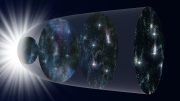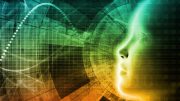
Simulations of a region of space 100 million light-years square. The leftmost simulation ran at low resolution. Using machine learning, researchers upscaled the low-res model to create a high-resolution simulation (right). That simulation captures the same details as a conventional high-res model (middle) while requiring significantly fewer computational resources. Credit: Y. Li et al./Proceedings of the National Academy of Sciences 2021
Using neural networks, Flatiron Institute research fellow Yin Li and his colleagues simulated vast, complex universes in a fraction of the time it takes with conventional methods.
Using a bit of machine learning magic, astrophysicists can now simulate vast, complex universes in a thousandth of the time it takes with conventional methods. The new approach will help usher in a new era in high-resolution cosmological simulations, its creators report in a study published online on May 4, 2021, in Proceedings of the National Academy of Sciences.
“At the moment, constraints on computation time usually mean we cannot simulate the universe at both high resolution and large volume,” says study lead author Yin Li, an astrophysicist at the Flatiron Institute in New York City. “With our new technique, it’s possible to have both efficiently. In the future, these AI-based methods will become the norm for certain applications.”
The new method developed by Li and his colleagues feeds a machine learning algorithm with models of a small region of space at both low and high resolutions. The algorithm learns how to upscale the low-res models to match the detail found in the high-res versions. Once trained, the code can take full-scale low-res models and generate ‘super-resolution’ simulations containing up to 512 times as many particles.
The process is akin to taking a blurry photograph and adding the missing details back in, making it sharp and clear.
This upscaling brings significant time savings. For a region in the universe roughly 500 million light-years across containing 134 million particles, existing methods would require 560 hours to churn out a high-res simulation using a single processing core. With the new approach, the researchers need only 36 minutes.
The results were even more dramatic when more particles were added to the simulation. For a universe 1,000 times as large with 134 billion particles, the researchers’ new method took 16 hours on a single graphics processing unit. Existing methods would take so long that they wouldn’t even be worth running without dedicated supercomputing resources, Li says.
Li is a joint research fellow at the Flatiron Institute’s Center for Computational Astrophysics and the Center for Computational Mathematics. He co-authored the study with Yueying Ni, Rupert Croft and Tiziana Di Matteo of Carnegie Mellon University; Simeon Bird of the University of California, Riverside; and Yu Feng of the University of California, Berkeley.
Cosmological simulations are indispensable for astrophysics. Scientists use the simulations to predict how the universe would look in various scenarios, such as if the dark energy pulling the universe apart varied over time. Telescope observations may then confirm whether the simulations’ predictions match reality. Creating testable predictions requires running simulations thousands of times, so faster modeling would be a big boon for the field.
Reducing the time it takes to run cosmological simulations “holds the potential of providing major advances in numerical cosmology and astrophysics,” says Di Matteo. “Cosmological simulations follow the history and fate of the universe, all the way to the formation of all galaxies and their black holes.”
So far, the new simulations only consider dark matter and the force of gravity. While this may seem like an oversimplification, gravity is by far the universe’s dominant force at large scales, and dark matter makes up 85 percent of all the ‘stuff’ in the cosmos. The particles in the simulation aren’t literal dark matter particles but are instead used as trackers to show how bits of dark matter move through the universe.
The team’s code used neural networks to predict how gravity would move dark matter around over time. Such networks ingest training data and run calculations using the information. The results are then compared to the expected outcome. With further training, the networks adapt and become more accurate.
The specific approach used by the researchers, called a generative adversarial network, pits two neural networks against each other. One network takes low-resolution simulations of the universe and uses them to generate high-resolution models. The other network tries to tell those simulations apart from ones made by conventional methods. Over time, both neural networks get better and better until, ultimately, the simulation generator wins out and creates fast simulations that look just like the slow conventional ones.
“We couldn’t get it to work for two years,” Li says, “and suddenly it started working. We got beautiful results that matched what we expected. We even did some blind tests ourselves, and most of us couldn’t tell which one was ‘real’ and which one was ‘fake.’”
Despite only being trained using small areas of space, the neural networks accurately replicated the large-scale structures that only appear in enormous simulations.
The simulations don’t capture everything, though. Because they focus only on dark matter and gravity, smaller-scale phenomena — such as star formation, supernovae and the effects of black holes — are left out. The researchers plan to extend their methods to include the forces responsible for such phenomena, and to run their neural networks ‘on the fly’ alongside conventional simulations to improve accuracy. “We don’t know exactly how to do that yet, but we’re making progress,” Li says.
Reference: “AI-assisted superresolution cosmological simulations” by Yin Li, Yueying Ni, Rupert A. C. Croft, Tiziana Di Matteo, Simeon Bird and Yu Feng, 4 May 2021, Proceedings of the National Academy of Sciences.
DOI: 10.1073/pnas.2022038118









The idea is to match the statistical properties (see the abstract).
Thanks for this. Creating high resolution from low does appear like “magic” without some additional information or constraints.
Matching statistical properties and forcing adherence to basic laws of physics helps in some remote sensing work a colleague is doing.
Interesting analog, remote sensing is hard so I can sort of see how that works.
Yes, I scratched my head. Then read the abstract for an explanation (and was lucky enough to find it already there).
That sounds like it’s not really any different than https://github.com/mxgmn/WaveFunctionCollapse which takes small patches of a type and produces larger regions that look like the parts but scrambled…
Babu G. Ranganathan*
(B.A. Bible/Biology)
JUST BECAUSE SCIENCE CAN EXPLAIN how an airplane works doesn’t mean that no one designed or made the airplane. And just because science can explain how life or the universe works doesn’t mean there was no Designer and Maker behind them.
Natural laws may explain how the order in the universe works and operates, but mere undirected natural laws cannot explain the origin of that order. Once you have a complete and living cell then the genetic code and biological machinery exist to direct the formation of more cells from raw materials such as amino acids and other chemicals, but how could life or the cell have naturally originated when no directing code and mechanisms existed in nature? Read my Internet article: HOW FORENSIC SCIENCE REFUTES ATHEISM.
WHAT IS SCIENCE? Science simply is knowledge based on observation. No human observed the universe coming by chance or by design, by creation or by evolution. These are positions of faith. The issue is which faith the scientific evidence best supports.
SCIENCE SHOWS THAT THE UNIVERSE CANNOT BE ETERNAL because it could not have sustained itself eternally due to the law of entropy (increasing and irreversible net energy decay, even in an open system). Even a hypothetical oscillating universe could not continue to oscillate eternally! Einstein’s General Theory of Relativity shows that space, matter, and time all are physical and all had a beginning. Space even produces particles because it’s actually something, not nothing. What about the Higgs boson (the so-called “God Particle”)? The Higgs boson, even if it existed, would not have created mass from nothing, but rather it would have converted energy into mass. Einstein showed that all matter is some form of energy. Even time had a beginning! Time is not eternal.
The law of entropy doesn’t allow the universe to be eternal. If the universe were eternal, everything, including time (which modern science has shown is as physical as mass and space), would have become totally entropied by now and the entire universe would have ended in a uniform heat death a long, long time ago. The fact that this hasn’t happened already is powerful evidence for a beginning to the universe.
Popular atheistic scientist Stephen Hawking admits that the universe had a beginning and came from nothing but he believes that nothing became something by a natural process yet to be discovered. That’s not rational thinking at all, and it also would be making the effect greater than its cause to say that nothing created something. The beginning had to be of supernatural origin because science teaches us from the First Law of Thermodynamics that natural laws and processes do not have the ability to bring something into existence from nothing.
The supernatural origin of the universe cannot be proved by science but science points to a supernatural intelligence and power for the origin and order of the universe. Where did God come from? Obviously, unlike the universe, God’s nature doesn’t require a beginning.
The disorder in the universe can be explained because of chance and random processes, but the order can be explained only because of intelligence and design.
Gravity may explain how the order found in the precise and orderly courses of thousands of billions of stars is maintained, but gravity cannot explain the origin of that order.
Some evolutionary astronomers believe that trillions of stars crashed into each other leaving surviving stars to find precise orderly orbits in space. Not only is this irrational, but if there was such a mass collision of stars then there would be a super mass residue of gas clouds in space to support this hypothesis. The present level of residue of gas clouds in space doesn’t support the magnitude of star deaths required for such a hypothesis. And, as already stated, the origin of stars cannot be explained by the Big Bang because of the reasons mentioned above. It’s one thing to say that stars may decay and die into random gas clouds, but it is totally different to say that gas clouds form into stars.
Even the father of Chaos theory admitted that the “mechanisms” existing in the non-living world allow for only very rudimentary levels of order to arise spontaneously (by chance), but not the kind or level of order we find in the structures of DNA, RNA, and proteins. Yes, individual amino acids have been shown to come into existence by chance but not protein molecules which require that the various amino acids be in a precise sequence just like the letters found in a sentence.
Some things don’t need experiment or scientific proof. In law there is a dictum called prima facie evidence. It means “evidence that speaks for itself.”
An example of a true prima facie would be if you discovered an elaborate sand castle on the beach. You don’t have to experiment to know that it came by design and not by the chance forces of wind and water.
If you discovered a romantic letter or message written in the sand, you don’t have to experiment to know that it was by design and not because a stick randomly carried by wind put it there. You naturally assume that an intelligent and rational being was responsible.
It’s interesting that Carl Sagan would have acknowledged sequential radio signals in space as evidence of intelligent life sending them, but he wouldn’t acknowledge the sequential structure of molecules in DNA (the genetic code) as evidence of an intelligent Cause. Read my popular Internet article, HOW DID MY DNA MAKE ME.
I encourage all to read my popular Internet articles:
NATURAL LIMITS TO EVOLUTION
HOW FORENSIC SCIENCE REFUTES ATHEISM
Visit my latest Internet site: THE SCIENCE SUPPORTING CREATION (This site answers many arguments, both old and new, that have been used by evolutionists to support their theory)
Author of popular Internet article, TRADITIONAL DOCTRINE OF HELL EVOLVED FROM GREEK ROOTS
*I have given successful lectures (with question and answer period afterwards) defending creation before evolutionist science faculty and students at various colleges and universities. I’ve been privileged to be recognized in the 24th edition of Marquis “Who’s Who in The East” for my writings on religion and science.
Meaningless superstition; self promoting material.
It looks like a bot is looking for keywords as trigger, when pasting much the same junk every time.
Does a B.A. in Bible/Biology include learing how to use striped and notched sticks in front of copulating livestock to determine their phenotype?
So what is it supposed to emulate? It looks made up since biology contradicts the myth, as all the other sciences. And the comment is incoherent and not engaging in the science of the article it is posted under.
“Bachelor of Arts”? “Business Associate”? “Bulls#!t Artist”?